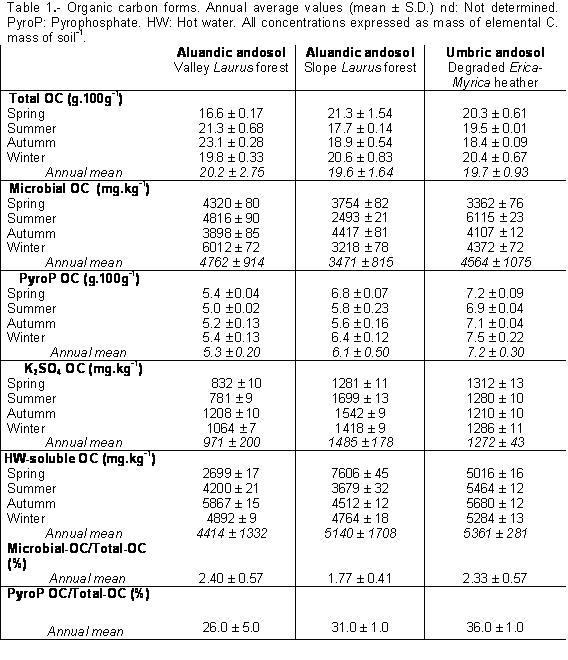
Saturday, 15 July 2006
126-21
Seasonal Dynamics of Organic Carbon Stocks and Forms in Andosols of the Canary Islands (Spain).
Antonio Rodríguez-Rodríguez, Cecilia M. Armas, Carmen D. Arbelo, J. Asterio Guerra, Bayanor Santana, Jesús S. Notario, and Juan L. Mora. University of La Laguna, Avda. Astrofísico Fco. Sánchez, La Laguna (Canary Is.), Spain
Soil organic C contents vary seasonally due to fluctuations in temperature and moisture, but also according to other factors, such as changes in land use, vegetation characteristics, soil properties, etc. The different forms of organic C (labile/recalcitrant, biomass-linked, or chemically extractable organic C) result from the dynamics of C in soils. Regardless the soil organic C (SOC) content, only a small fraction of it is readily available for microorganisms, and its amounts and nature may be subjected to different patterns of seasonal fluctuations. Andosols are characterized by a high SOC content, due to the stabilization of humic substances by short-range ordered minerals or by amorphous hidroxy-Al compounds, which conferes organic C a high resistance to microbial decomposition. Very few studies have been made so far on the organic C forms and stocks that predominate in every season in Andosols. The aim of this paper is to fill such a gap, by characterizing the seasonal pattern of SOC forms and some related enzymatic activities in Andosols of the Canary Islands. A field study has been carried out in three plots. Two of them lie on Aluandic andosols (Eutric and Lithic fulvudands) under laurel forest, and another one lies on Umbric andosols (Ultic hapludands) under Erica-Myrica heather forest. The soils overlie deeply weathered ferralithic saprolite rock, derived from pliocenic basalts. The high annual rainfall rates (850-1100 mm.yr-1) give rise to an Udic soil moisture regime. Mean annual temperature and the estimated potential evapotranspiration are 14ºC and 600 mm.yr-1, respectively. The seasonal (july, october, january and april) pattern for selected SOC forms (microbial biomass C, total SOC, pyrophosphate-extractable organic C, potassium sulphate-extractable organic C, and water-soluble organic C) in surface (15 cm) soil samples has been assessed on a one-year term basis. The obtained results show that Andosols are rich in total SOC (166-231 g C.kg-1) and in microbial biomass (2.49-6.11 g C.kg-1), as expectable, being these levels higher than those reported elsewhere for volcanic ash-derived soils. Pyrophosphate-extractable organic C represents about one third (26-36%) of the total SOC. The average biomass to total organic C ratio ranges between 1.8 and 2.4%, much higher than that reported for Japanese Andosols (0.2%) or in the COST622 Volcanic Soils of Europe reference (1.3-1.7%). Moreover, microbial organic C correlates poorly with the total SOC content (r = 0.44). In general, hot water was more effective than K2SO4 as a extractant for labile organic C forms, and correlates fairly with total SOC (r = 0.87). The water-soluble organic C exceeds the microbial organic C content (mean ratio = 1.2), as reported for allophanic Andosols in New Zealand (mean ratio = 3 – 7). The highest total SOC contents occur in winter and spring, which coincides with the highest soil moisture values. The highest values for other organic C forms (microbial biomass organic C, water- and potassium sulphate-extractable organic C) can be found during spring and summer. No significant seasonal fluctuations have been found for pyrophoshate-extractable organic C. The high microbial biomass carbon content measured coincides with the maximum litter supplies to soil. The most active microbial biomass occurs at Umbric Andosols, characterized by intense mineralization processes, as shown by the enzymatic activities.

Back to 1.3PA Andisols and Related Soils - Poster
Back to WCSS
Back to The 18th World Congress of Soil Science (July 9-15, 2006)